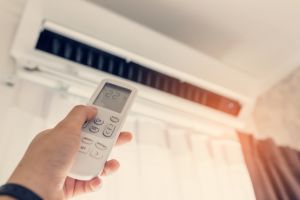No-one wants to have cold feet over winter. We want to be toasty in our homes, whether that’s lounging in front of the telly, in bed with a good book or working in the home office. But it’s a real pain when you’ve installed heating and it’s not acting as efficiently as it could. Especially, because heating in New Zealand isn’t cheap. Typically heating accounts for about 30% of a household’s annual energy consumption, according to Smarter Homes.
However, there are some mistakes to avoid when heating your home to make sure your existing heating methods are working as well as they can. Canstar lays out these mistakes and some simple fixes below.

1. Not insulating your home thoroughly
Insulating your home reduces the amount of heating you need to keep your home at a comfortable temperature. Always insulate first, starting with a home’s ceilings and floors. Ensuring your home is well insulated is the first step in getting the most energy efficient performance from any heating option.
Even if there’s already insulation in your house, it could have lost some of its performance over the years. Ceilings are often the easiest and most effective areas to insulate in an existing house. If the roof space is accessible, bulk insulation can simply be placed over your ceiling lining and framing. For some home insulation measures there are even government grants that make them more affordable. Quality, thermally lined curtains can also prevent heat loss from windows in particularly cold areas. Double-glazed windows are also an option and can cut heat loss down considerably.
2. Location, location: the positioning of your heating
The location of heaters and heat pumps can make a big difference in terms of their effectiveness. For electric heaters, you should position convection, oil column or micathermic heaters on the cold side of a room, for example, near a window, if possible. Heated air will mix with the cold downdraught from the window, resulting in better heat distribution. Just make sure the heater is well away from curtains.
Heat pump units come in three types: high-wall, floor-mounted console and ceiling units. Floor-mounts are the best for quick heating, but make sure the air flow isn’t blocked by furniture. High-wall heat pumps are also a good option and newer models are relatively subtle when placed on a wall. It’s best not to put them close to any areas where people sit, such as directly facing a couch. If the heat pump is installed facing a hallway or doors to other rooms, you could potentially opt for a ducted heat pump, which will act like a central heating system. It flows air via ceiling or floor ducts throughout the house.

3. Not using the right kind of heating for your space
Heating can be far less effective in your home if you’re not using the optimal heating method for your space. For larger rooms that you want to heat regularly, like a living room, for example, it’s worth paying a bit more upfront for a fixed heater. These typically have lower running costs and give out greater heat than a small electric heater. These types of heaters include: modern wood burners, energy efficient heat pumps, or flued gas heaters.
How effective are fires?
Generally, open fires will be draughty and provide insufficient heat to warm a room. Modern, enclosed wood burners are much more efficient than open fires, and are good for heating large areas. They can result in overheating, though, if the heat isn’t moved around through open doors or through a heat transfer system.
Is an electric heater right for me?
Electric heaters are most useful if you want to provide warmth for a single person or a single room. As a general rule:
- Use panel heaters and oil-filled column heaters in well-insulated homes that don’t require a lot of heating, or to heat a single room, such as a bedroom.
- Use radiant heaters in poorly insulated homes, since they radiate warmth directly onto you, or in spaces you’ll only use for short periods.
It’s important to choose a heater that’ll be suitable for the space you intend to heat, as an inappropriately sized heater may not only deliver too much or too little heat, it could also drive up your power bills.
What about heat pumps?
Heat pumps are among the most energy-efficient forms of heating appliances available. They’re controlled using a thermostat, so you can set them to keep your home within a specific temperature range at different times of the day. They’re good for room-specific heating, but think about size carefully. If the unit is too small for the room you’re heating, it may cost you more to run and will struggle to provide enough heat when you most need it. The NZ Tenancy site has a good heating assessment tool you can use for free.
Compare heat pumps with Canstar
4. Not cleaning your heat pump filter
According to Genesis Energy, over a quarter of Kiwi households use a heat pump. Make sure to clean both your indoor and outdoor heat pump filter regularly, at least once a year, to ensure the heat pump heats to its full potential. This is a quick and easy process, unless the placement of the outside unit is tricky to get to.
5. Ignoring draughts
Don’t ignore draughts in your home. Check all your doors, windows, and exterior walls for drafts. Seal any areas where cold air is sneaking in, or where warm air could leak out. As a rule of thumb, all houses built before the 1960s, and most houses built before the 1980s, will need some draught stopping. You can use things like self-adhesive foam strips and draught sausages to fight cold draughts.

6. Cranking heating too high
Cranking up the thermostat further than you need won’t help heat your home any faster. It just translates into a higher power bill at the month’s end. If you’ve come home to a chilly living room, turning a heat pump on and blasting it at 30°C won’t warm your room any faster, although it will cost you a lot more. Set it lower and be patient. If you’re concerned about the cost of your power bills, perhaps it’s time to see whether you’re on the best plan for your household.
Check out the table below for Canstar’s ratings on the electricity providers that offer the best customer satisfaction and value for money:
Canstar Blue’s latest review of NZ power companies compares them on customer satisfaction. The table below is an abridged version of our full results, available here.
^ By clicking on a brand or 'details' button, you will leave Canstar Blue and be taken to either a product provider website or a Canstar Blue NZ brand page. You agree that Canstar Blue NZ’s terms and conditions apply (without limitation) to your use of this service,to any referral to a product provider from our website, and any transaction that follows. Canstar Blue may earn a fee for referrals from its website tables, and from sponsorship (advertising) of certain products. Payment of sponsorship fees does not influence the star rating that Canstar Blue awards to a sponsored product. Fees payable by product providers for referrals and sponsorship may vary between providers, website position, and revenue model. Sponsorship fees may be higher than referral fees. Sponsored products are clearly disclosed as such on website pages. They may appear in a number of areas of the website such as in comparison tables, on hub pages and in articles. Sponsored products may be displayed in a fixed position in a table, regardless of the product’s rating, price or other attributes. The table position of a sponsored product does not indicate any ranking, rating or endorsement by Canstar Blue. See How we are funded for further details.
Canstar Blue NZ Research finalised in April 2023, published in June 2023.
See Our Ratings Methodology
7. Not opening curtains and windows during the day
It may seem obvious, but open your curtains during the day and close them at night. Your windows let in heat during the day. Closing curtains before sunset helps keep the warmth in, and the cold out. Opening your windows during the day will also assist to heat your home, as ventilation helps to keep your home dry, which in turn makes it easier and cheaper to heat.
Compare electricity providers for free with Canstar!
Enjoy reading this article?
You can like us on Facebook and get social, or sign up to receive more news like this straight to your inbox.
By subscribing you agree to the Canstar Privacy Policy


Share this article